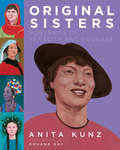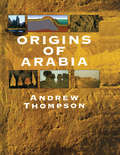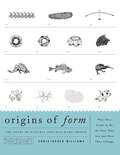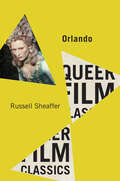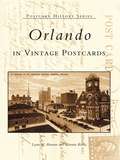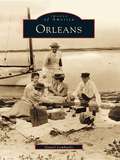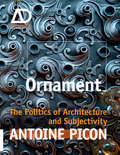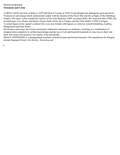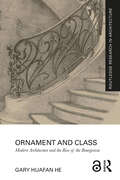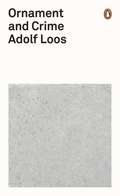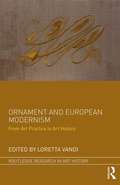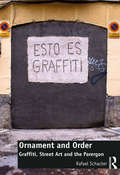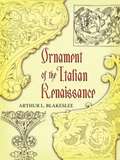- Table View
- List View
Original Sisters: Portraits of Tenacity and Courage (Pantheon Graphic Library)
by Anita KunzFrom the internationally acclaimed artist, a stunning collection of portraits of ground-breaking women—Joan of Arc, Josephine Baker, Greta Thunberg, Misty Copeland, and many more history-making women whose names have been forgotten and are finally being brought to light. With a Foreword by Roxane Gay.&“This book, as a whole, offers the reader possibility and promise … You will be introduced to many of these women for the first time, because history is rarely kind to women until it is forced to be. You will learn about artists and activists, rulers and rebels.&” —Roxane Gay, from the Foreword Original Sisters was born from the COVID-19 quarantine. In early March 2020, locked down in her home-studio in Toronto and longing for inspiration, artist Anita Kunz started researching women on the Internet. She wasn&’t sure what she was looking for, but she soon found an array of astonishing people who had done amazing things—some of whom she had heard of, but most of whom she had not. And then she began to paint their pictures and write down their stories. The result is a jaw-dropping feat of historic and artistic research. The wide variety of lives, occupations, time periods, and achievements is absolutely mind-bending. From Joan of Arc to Josephine Baker, from Hippolyta to Greta Thunberg, from Anne Frank to Misty Copeland: these women made and changed history. But there are just as many whom you&’ve never heard of, who were never recognized in their lifetimes, whose achievements need to be brought to light. They include the anti-Nazi activist Sophie Scholl, who was executed at age twenty-one by the Third Reich, and Alice Ball, a young African American scientist who discovered a treatment for leprosy but died tragically before she could receive credit for it.This is not only a breathtaking art book. Original Sisters also recounts a secret history that must be told so that it is a secret no more.
Origins of Arabia
by Andrew ThompsonFirst Published in 2000. Routledge is an imprint of Taylor & Francis, an informa company.
Origins of Form: The Shape of Natural and Man-made Things—Why They Came to Be the Way They Are and How They Change
by Christopher WilliamsOrigins of Form is about the shape of things. What limits the height of a tree? Why is a large ship or office building more efficient than a small one? What is the similarity between a human rib cage and an airplane or a bison and a cantilevered bridge? How might we plan for things to improve as they are used instead of wearing out? The author has chosen eight criteria that constitute the major influences on three-dimensional form. These criteria comprise the eight chapters of the book: each looks at form from entirely different viewpoints. The products of both nature and man are examined and compared.This book will make readers—especially those who design and build—aware of their physical environment and how to break away from previously held assumptions and indifference about the ways forms in our human environment have evolved. It shows better ways to do things. The author&’s practical, no-nonsense approach and his exquisite drawings, done especially for this volume, provide a clear understanding of what can and cannot be; how big or small an object should be, of what material it will be made, how its function will relate to its design, how its use will change it, and what laws will influence its development.The facts and information were gathered from many sources: the areas of mechanics, structure, and materials; geology, biology, anthropology, paleobiology, morphology and others. These are standard facts in these areas of specialization, but they are also essential to the designer&’s overall knowledge and understanding of form. The result is an invaluable work for students, designers, architects, and planners, and an informed introduction to a fascinating subject for laymen.
Orlando (Queer Film Classics)
by Russell SheafferA film that transcends time, Sally Potter’s Orlando follows its titular character through nearly four hundred years of British history. Orlando starts life as a young man in the 1600s and then, mid-film, becomes a woman in the 1800s. Plot, production, and performance have all contributed to the film becoming a touchstone for Tilda Swinton’s ethereal and gender-bending mode.A Russian-French-Dutch-American-Italian-British co-production, Orlando was hailed as a monumental work of international art house cinema upon its release in 1992. Some understood Potter’s film, a work of ruthless and ingenious adaptation, as moving away from the lesbian content of Virginia Woolf’s novel. Russell Sheaffer uses a detailed analysis of screenplay drafts and more than three decades of reception to argue that while the film moves away from a direct investment in same-sex relationships, Orlando’s articulations of embodiment, desire, and time have made the film continually more queer in the years since its release.Taking cues from adaptation theory and gender studies, this book meticulously charts the distinct shift from lesbian feminist text to queer film classic, arguing that the film is as much an adaptation of Woolf’s A Room of One’s Own as it is of its eponymous novel.
Orlando in Vintage Postcards (Postcard History)
by Lynn M. Homan Thomas Reilly"Beautiful weather here. When are you coming?" Those words have been written millions of times on postcards mailed from Orlando. Known today as home to America's most famous theme parks, Orlando has always been a destination for visitors from all over the world. During its early period as "The Phenomenal City," through the years as "The City Beautiful," to the era of "The Action Center of Florida," Orlando has a story to tell.
Orleans
by Daniel LombardoOrleans, at the crook of Cape Cod's elbow, is a place of extraordinary beauty and unforgettable people. From the first known Cape Cod shipwreck, the Sparrowhawk in 1626, to the last Cape Cod wreck of a sailing ship, the Montclair in 1927, the town is bursting with tales to be told. There are the quiet stories of windmills, quahog fishermen, and cranberry harvesters set against the hanging of pirates, the threat of sea serpents, and attacks on Orleans by foreign countries. People flock to Rock Harbor on the west to watch the fishing boats go out or to watch the sun go down. Town Cove, with its windmill and inn, is on the north. To the east and south, Orleans opens up to the great Atlantic. The long spit of Nauset Beach is battered by the sea, as it protects Pleasant Bay and Pochet, Sampson, and Hog islands. With vivid photographs, Orleans brings to life the era of sailors such as Captain Linnell, who was as familiar with Calcutta and Hong Kong as he was with Rock Harbor; the time that Henry David Thoreau stayed at Higgins Tavern and met two young Italian organ grinders; and the day of the bombing of Orleans, when the Ainsleigh boy threatened a German submarine with his .22-caliber rifle.
Ornament
by Antoine PiconOnce condemned by Modernism and compared to a 'crime' by Adolf Loos, ornament has made a spectacular return in contemporary architecture. This is typified by the works of well-known architects such as Herzog & de Meuron, Sauerbruch Hutton, Farshid Moussavi Architecture and OMA. There is no doubt that these new ornamental tendencies are inseparable from innovations in computer technology. The proliferation of developments in design software has enabled architects to experiment afresh with texture, colour, pattern and topology.Though inextricably linked with digital tools and culture, Antoine Picon argues that some significant traits in ornament persist from earlier Western architectural traditions. These he defines as the 'subjective' - the human interaction that ornament requires in both its production and its reception - and the political. Contrary to the message conveyed by the founding fathers of modern architecture, traditional ornament was not meant only for pleasure. It conveyed vital information about the designation of buildings as well as about the rank of their owners. As such, it participated in the expression of social values, hierarchies and order. By bringing previous traditions in ornament under scrutiny, Picon makes us question the political issues at stake in today's ornamental revival. What does it tell us about present-day culture? Why are we presently so fearful of meaning in architecture? Could it be that by steering so vehemently away from symbolism, contemporary architecture is evading any explicit contribution to collective values?
Ornament And Crime
by Adolf LoosAdolf Loos, the great Viennese pioneer of modern architecture, was a hater of the fake, the fussy and the lavishly decorated, and a lover of stripped down, clean simplicity. He was also a writer of effervescent, caustic wit, as shown in this selection of essays on all aspects of design and aesthetics, from cities to glassware, furniture to footwear, architectural training to why 'the lack of ornament is a sign of intellectual power'.
Ornament and Class: Modern Architecture and the Rise of the Bourgeoisie (Routledge Research in Architecture)
by Gary Huafan HeThis groundbreaking study examines the intricate relationship between the rise of the nineteenth-century bourgeoisie and the emergence of modern architecture, exploring this connection through major intellectual and theoretical works while also analyzing their tangible manifestations in buildings and architectural projects.Contrary to received narratives that describe the birth of modern architecture as primarily an aesthetic movement, Ornament and Class argues that the social and political maturation of the European bourgeoisie as a distinct-yet-heterogeneous group influenced modern attitudes toward architecture at every level. Bringing architecture into conversation with recent histories of the bourgeoisie in the social sciences, the book considers how architecture was used as a tool to separate the modern bourgeoisie from the aristocratic and clerical forces above and the working classes below. It explores how architects, clients, planners, and administrators grappled with and dealt with ornament, architecture, and modernity from within the new realities of urban and global capitalism, and shows how these realities serve as pedagogical touchstones that remain with us today.Historians, architecture scholars, and students interested in modern architecture, aesthetics, and European history, especially those focusing on the interplay between modern architecture and social development, will find this book an invaluable resource.
Ornament and Crime
by Adolf LoosRevolutionary essays on design, aesthetics and materialism - from one of the great masters of modern architectureAdolf Loos, the great Viennese pioneer of modern architecture, was a hater of the fake, the fussy and the lavishly decorated, and a lover of stripped down, clean simplicity. He was also a writer of effervescent, caustic wit, as shown in this selection of essays on all aspects of design and aesthetics, from cities to glassware, furniture to footwear, architectural training to why 'the lack of ornament is a sign of intellectual power'.Translated by Shaun WhitesideWith an epilogue by Joseph Masheck
Ornament and European Modernism: From Art Practice to Art History (Routledge Research in Art History)
by Loretta VandiThese in-depth, historical, and critical essays study the meaning of ornament, the role it played in the formation of modernism, and its theoretical importance between the mid-nineteenth century and the late twentieth century in England and Germany. Ranging from Owen Jones to Ernst Gombrich through Gottfried Semper, Alois Riegl, August Schmarsow, Wilhelm Worringer, Adolf Loos, Henry van de Velde, and Hermann Muthesius, the contributors show how artistic theories are deeply related to the art practice of their own times, and how ornament is imbued with historical and social meaning.
Ornament and Monstrosity in Early Modern Art (Visual and Material Culture, 1300-1700)
by Chris Askholt Hammeken Maria Fabricius HansenEarly modern art features a remarkable fascination with ornament, both as decorative device and compositional strategy, across artistic media and genres. Interestingly, the inventive, elegant manifestations of ornament in the art of the period often include layers of disquieting paradoxes, creating tensions - monstrosities even - that manifest themselves in a variety of ways. In some cases, dichotomies (between order and chaos, artificiality and nature, rational logic and imaginative creativity, etc.) may emerge. Elsewhere, a sense of agitation undermines structures of statuesque control or erupts into wild, unruly displays of constant genesis. The monstrosity of ornament is brought into play through strategies of hybridity and metamorphosis, or by the handling of scale, proportion, and space in ambiguous and discomforting ways that break with the laws of physical reality. An interest in strange exaggeration and curious artifice allows for such colossal ornamental attitude to thrive within early modern art.
Ornament and Order: Graffiti, Street Art and the Parergon
by Rafael SchacterOver the last forty years, graffiti and street-art have become a global phenomenon within the visual arts. Whilst they have increasingly been taken seriously by the art establishment (or perhaps the art market), their academic and popular examination still remains within old debates which argue over whether these acts are vandalism or art, and which examine the role of graffiti in gang culture and in terms of visual pollution. Based on an in-depth ethnographic study working with some of the world’s most influential Independent Public Artists, this book takes a completely new approach. Placing these illicit aesthetic practices within a broader historical, political, and aesthetic context, it argues that they are in fact both intrinsically ornamental (working within a classic architectonic framework), as well as innately ordered (within a highly ritualized, performative structure). Rather than disharmonic, destructive forms, rather than ones solely working within the dynamics of the market, these insurgent images are seen to reface rather than deface the city, operating within a modality of contemporary civic ritual. The book is divided into two main sections, Ornament and Order. Ornament focuses upon the physical artifacts themselves, the various meanings these public artists ascribe to their images as well as the tensions and communicative schemata emerging out of their material form. Using two very different understandings of political action, it places these illicit icons within the wider theoretical debate over the public sphere that they materially re-present. Order is focused more closely on the ephemeral trace of these spatial acts, the explicitly performative, practice-based elements of their aesthetic production. Exploring thematics such as carnival and play, risk and creativity, it tracks how the very residue of this cultural production structures and shapes the socio-ethico guidelines of these artists’ lifeworlds.
Ornament and Symbol in French Romantic Architecture: Simon-Claude Constant-Dufeux
by Ralph GhocheFor Simon-Claude Constant-Dufeux (1801–1871), a radical French architect and chair of perspective at the École des Beaux-Arts in Paris, the study and composition of ornament were essential pursuits. Architectural emblems and ornaments were symbols that conveyed concise and immediate meaning; they were also a crucial element in realizing the Romantic ideal of the synthesis of the arts.Through the lens of Constant-Dufeux’s work, Ornament and Symbol in French Romantic Architecture explores the sudden proliferation of ornamental motifs in France, challenging the understanding that the twentieth-century modernist avant-garde developed in direct opposition to ornament. Ralph Ghoche examines architectural ornament from the July Monarchy to the Second Empire, revealing its connections to Romantic theories of symbolism and ideas about the power of form to elicit emotional responses. Ghoche repositions Constant-Dufeux as a pivotal figure in developing new forms of symbolic signification in architecture, establishing him as one of Romanticism’s key theoreticians.Ornament and Symbol in French Romantic Architecture reconstructs vibrant debates surrounding theories of the symbol, the public function of architecture, and the quest for the synthesis of the arts, revealing architectural ornamentation to be part of a process of modernization that continued into the next generation of architects and artists, ultimately culminating in the advent of art nouveau.
Ornament of the Italian Renaissance
by Arthur L. BlakesleeThis glorious gallery of stunning architectural accents from Italy's Middle Ages has been assembled from a rare, early-twentieth-century publication: * Grotesques from carved panels of choir stalls* Breathtaking tombstone and ceiling ornaments * Sumptuous stone balcony panels... and much more, all reproduced in sixty richly detailed illustrations. Designers and artists of every variety will revel in this modestly priced treasury of authentic Renaissance style.
Ornamental Borders, Scrolls and Cartouches in Historic Decorative Styles (Dover Pictorial Archive)
by Syracuse Ornamental Co.Hundreds of beautiful copyright-free line illustrations of intricately carved furniture trimmings. Delicate floral wreaths, scrolls, more.
Ornamental Designs from Architectural Sheet Metal: The Complete Broschart & Braun Catalog, ca. 1900 (Dover Pictorial Archive)
by Wm. A. Braun Jacob BroschartA must for architectural historians, restoration specialists and vintage home enthusiasts: 1,095 late Victorian-era designs, superbly drawn or photographed, including egg and dart enrichments; bead, flute and ogee enrichments; drapery and drop ornaments; urns, vases and wreaths; eagles, lion heads and gargoyles; rosettes, ribbons, garlands and festoons; sunbursts, weather vanes and more.
Ornamental Ironwork: Over 670 Illustrations (Dover Pictorial Archive)
by A. DurenneFinely detailed illustrations, selected from rare turn-of-the-century sources, provide striking examples of decorative ironwork designed to embellish balconies, gates, window grilles, staircases, doorways, and other architectural features. A rich source of inspiration and elegant, royalty-free material for graphic artists, designers, and craftworkers.
Ornamental Lakes: Their Origins and Evolution in English Landscapes
by Wendy BishopOrnamental Lakes traces the history of lakes in England, from their appearance in the early eighteenth century, through their development in the 1750s, and finally to their decline in the nineteenth century. Aside from the natural lakes in the Lake District, the bodies of water we see in England today are man-made, primarily intended to ornament the landscapes of the upper classes. Through detailed research, author Wendy Bishop argues that, contrary to accepted thinking, the development of lakes led to the dissolution of formal landscapes rather than following changes in landscape design. Providing a comprehensive overview of lakes in England, including data on who made these lakes, how, and when, it additionally covers fishponds, water gardens, cascades and reservoirs. Richly illustrated and accompanied by case studies across the region, this book offers new insights in landscape history for students, researchers and those interested in how landscapes evolve.
Ornamental Turning: A Work of Practical Instruction in the Above Art ; With Numerous Engravings and Autotype Plates
by John H. EvansEvans, like his contemporaries, the Holtzapffels, was a manufacturer of high quality lathes; but he was also an accomplished turner and, for 33 years, the author of many articles for English Mechanic, a leading journal of the time. His broad combination of engineering and practical experience, along with his literary skills, makes Ornamental Turning one of the most useful books in the field. Clearly written and richly illustrated, with over 190 detailed line drawings and 19 plates, it provides a complete coverage of the subject. Included is information available nowhere else: a chapter on DawsonUs geometric slide rest, details on the design of many types of apparatus, and a brief chapter on electrotyping. This is a complete reprint of the original 1886 edition.
Ornaments of Death (Josie Prescott Antiques Mysteries)
by Jane K. ClelandChristmas lights twinkle throughout the cozy coastal town of Rocky Point, New Hampshire, and Prescott's Antiques auction venue has been transformed into a winter wonderland for Josie Prescott's annual holiday party. Josie is especially excited this year-Ian Bennington, a recently discovered distant relative, will be joining the fun. Both Ian and Josie are, it seems, descended from Arabella Churchill, a 17th century royal mistress. The party is a success and Ian is a hit. It gives Josie an unexpected thrill to have family-and unexpected dread when he vanishes.Ian doesn't keep his dinner date with Josie's good friend, Lavinia, or his lunch date with her. Surely, he would have done so-if he could. Ian has given his daughter two priceless 17th century watercolor miniature portraits, one of Arabella and one of her lover, King James II, and they've gone missing, too. Knowing that after her nasty divorce, Lavinia is facing financial ruin, Josie can't help wondering if her friend is behind the theft-and Ian's disappearance.Determined to find Ian, Josie uses her knowledge of antiques to track the miniatures. In doing so, she learns the true meaning of Christmas-and the true meaning of family. Jane Cleland's Ornaments of Death is another masterful addition to the Josie Prescott series.
Oro de rey: Luis Miguel. La biografía
by Francisco Javier León HerreraEsta nueva biografía, impactante y reveladora como las anteriores, profundiza en los aspectos más importantes de su vida. Desnuda al ser humano que hay detrás de la leyenda, comparte las claves de su extenso legado musical lleno de anécdotas y complicadas decisiones, así como el bagaje existencial de amor, dolor, amistades, traiciones, heridas familiares, sueños rotos, amargura y esperanza. Tras sus dos bestsellers sobre el Sol: Luis Mi Rey, biografía autorizada por el artista que sirvió de base para la serie televisiva sobre su vida, y el más reciente, Luis Miguel: la historia, Javier León Herrera y Juan Manuel Navarro completan la trilogía sobre la existencia del cantante más amado en México, Argentina, Colombia, Estados Unidos, Chile, Puerto Rico, Perú, Bolivia, Brasil, España, Italia y Centroamérica. Oro de Rey ayuda a comprender más al artista adentrándose en el adulto lejos de la sombra -no del fantasma- de Luisito Rey. Gracias a sus confesiones y al testimonio de las personas que más lo conocen, los autores desvelan, con rigor y respeto, a un Luis Miguel más íntimo. En estas páginas se descubrirán los miedos, las luces y las sombras de un luchador que no deja de preguntarse por qué ha tenido que nadar tanto tiempo refugiado en un caparazón, a contracorriente de su propio espíritu y deseo, urgido de una catarsis definitiva que cierre círculos y sane su alma de tantas heridas. Los autores se adentran en aspectos determinantes de su vida: sus huellas de abandono, la ausencia materna, su hogar roto, los hermanos separados, sus éxitos y su estancamiento en la más reciente y profunda crisis en la que tocó fondo: el "Trienio Horribilis" de 2015 a 2017, y su resurgir en 2018, con los detalles de su renacer con el que celebró 50 años: sus bodas de oro con la vida. ¡Larga vida al Rey!
Oro su Argento
by Elena Chernikova Paola SambrunaUn racconto di vita reale, sul ritorno alla vita. L'anima che esce dal corpo, difficilmente riesce a ritornarvi.
Orozco's American Epic: Myth, History, and the Melancholy of Race
by Mary K. CoffeyBetween 1932 and 1934, José Clemente Orozco painted the twenty-four-panel mural cycle entitled The Epic of American Civilization in Dartmouth College's Baker-Berry Library. An artifact of Orozco's migration from Mexico to the United States, the Epic represents a turning point in his career, standing as the only fresco in which he explores both US-American and Mexican narratives of national history, progress, and identity. While his title invokes the heroic epic form, the mural indicts history as complicit in colonial violence. It questions the claims of Manifest Destiny in the United States and the Mexican desire to mend the wounds of conquest in pursuit of a postcolonial national project. In Orozco's American Epic Mary K. Coffey places Orozco in the context of his contemporaries, such as Diego Rivera and David Alfaro Siqueiros, and demonstrates the Epic's power as a melancholic critique of official indigenism, industrial progress, and Marxist messianism. In the process, Coffey finds within Orozco's work a call for justice that resonates with contemporary debates about race, immigration, borders, and nationality.
Orphan Black Classified Clone Reports: The Secret Files of Dr. Delphine Cormier
by Delphine CormierThe ultimate guide to all of the characters, conspiracies, and shadowy organizations in the smart, innovative BBC America television thriller Orphan Black.Designed to resemble the classified files and notes of Dr. Delphine Cormier, this in-world compendium chronicles the inner workings of the mysterious people and organizations at the heart of the acclaimed hit television series Orphan Black. A detailed and creative look at the thrilling international hit series, Orphan Black Classified Clone Report includes detailed dossiers of Sarah Manning, Felix Dawkins, and all of the show’s beloved characters; examines every twist and turn from season one to the present; provides exclusive information on the Dyad Institute, the Neolution clone program, and the notorious Proletheans; and features observations of the different clones from their monitors, classified intelligence, breakthroughs in Cosima’s research, and private journal entries chronicling Delphine’s experience with the clone club and her own complicated love for Cosima.Packed with exclusive concept art, photos, and ephemera, Orphan Black Classified Clone Report is an immersive reading experience and essential companion for fans of Orphan Black.
